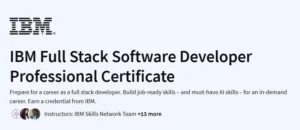What will you learn in Tracking the Cryptocurrency Market with CoinAPI using Python Course
Authenticate and interact with CoinAPI’s REST endpoints using Python and API keys
Fetch real-time and historical cryptocurrency data: assets, exchanges, trades, OHLCV, and order books
Retrieve and analyze exchange rates time series for currency conversion and portfolio evaluation
Parse JSON responses into Python objects and pandas DataFrames for downstream analysis
Integrate CoinAPI calls into a Django web app to build a live cryptocurrency market-data dashboard
Program Overview
Module 1: Introduction & CoinAPI Setup
⏳ 10 minutes
Topics: Course objectives, CoinAPI use cases, requesting and storing your API key
Hands-on: Generate a free CoinAPI key, configure it in your Python environment
Module 2: Metadata Endpoints
⏳ 15 minutes
Topics:
/v1/exchanges,/v1/assets,/v1/symbolsendpoints and response structuresHands-on: Fetch and display lists of available exchanges, assets, and trading symbols
Module 3: Market Data Basics
⏳ 20 minutes
Topics: Trades, OHLCV, Level-1 quotes, Level-2 and Level-3 order-book data
Hands-on: Write Python functions to retrieve recent trade streams and OHLCV candles
Module 4: Exchange Rates & Time Series
⏳ 15 minutes
Topics:
/v1/exchangerateand/v1/exchangerate/{asset_id}/historyfor spot and historical ratesHands-on: Fetch current BTC→USD rate and plot its historical time series
Module 5: Building a Django Market-Data App
⏳ 30 minutes
Topics: Django project setup, views, templates, and AJAX for live updates
Hands-on: Create a dashboard that displays asset prices and exchange-rate charts in real time
Module 6: Conclusion & Next Steps
⏳ 5 minutes
Topics: Recap, error handling, rate-limit awareness, and further CoinAPI features (e.g., quotes)
Hands-on: Sketch enhancements like caching, user portfolios, and alerting based on price thresholds
Get certificate
Job Outlook
Data Engineer / API Developer: $85,000–$125,000/year—integrate financial-market APIs into analytics pipelines
Quantitative Analyst (Entry-Level): $90,000–$130,000/year—leverage real-time crypto data for trading strategies
Full-Stack Python Developer: $80,000–$120,000/year—build data-driven dashboards and fintech applications
Proficiency with CoinAPI and Python positions you for roles in crypto-focused startups, fintechs, and data-science teams.
Specification: Tracking the Cryptocurrency Market with CoinAPI using Python Course
|
FAQs
- Teaches fetching real-time and historical cryptocurrency data for analysis.
- Provides skills to integrate data into dashboards or Python-based analytics pipelines.
- Does not cover order submission, trade execution, or exchange authentication.
- Useful for backtesting strategies or portfolio monitoring.
- Additional knowledge of exchange APIs is required for automated trading.
- Django integration is demonstrated step-by-step for building a live dashboard.
- Basic Python knowledge is enough to follow along with views, templates, and AJAX.
- Hands-on exercises illustrate integrating API calls into Django projects.
- Core Django concepts like routing and templates are introduced minimally.
- Advanced Django skills can be learned after completing the course for extended projects.
- Shows how to query CoinAPI for multiple asset prices and historical data.
- Teaches parsing JSON responses into Python objects and pandas DataFrames for analysis.
- Demonstrates visualization and dashboard updates for multiple cryptocurrencies.
- Scalable techniques allow extending to large datasets with minor adjustments.
- Performance optimization may require additional scripting knowledge.
- Prepares learners for roles like Data Engineer, API Developer, or Full-Stack Python Developer.
- Hands-on integration of CoinAPI and Python demonstrates practical, job-ready skills.
- Skills in real-time data handling, visualization, and dashboards are highly sought.
- Positions you for entry-level quantitative analyst roles with crypto data expertise.
- Enhances your resume for startups, fintechs, or data-centric teams.
- Covers plotting historical exchange-rate time series using Python.
- Demonstrates live updates in Django dashboards for selected assets.
- Focuses on clarity and functionality rather than advanced visual analytics.
- Skills learned can be extended with libraries like Plotly, Matplotlib, or Seaborn.
- Prepares you to create dashboards suitable for professional portfolio monitoring.




